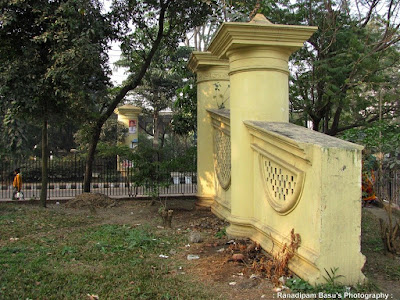Dhaka Gate: The Forgotten History of Dhaka City
Once upon a time, it wont to mark the terminus of the most
important city of undivided Bengal; currently it lies uncared for, surrounded
by bushes, covered by posters, during a shadowy corner of Dhaka University
campus. it's the Dhaka gate, popularly referred to as the gate of Mir Jumla,
the Mughal governor of Bengal, renowned for securing Dhaka and its inhabitants
from the raids of pirates and slave traders. From 17th to the start of the 19th
century, this gate was the most entrance to Dhaka city which, at that point ,
flourished on the banks of the Buriganga River.
 |
| Dhaka Gate in 1875. Photo: Courtesy |
According to popular belief, during the reign of Mughal
emperor, Aurangazeb, Dhaka, the capital of Bengal – a Mughal province much
larger than current Bangladesh – began to expand rapidly. The then governor of
Bengal, Mir Jumla, surveyed the town to create some fortresses and gates to
guard its citizens from the Magh pirates. After determining the town area, Mir
Jumla, in around 1663 AD, erected this gate to mark the northern entrance of
Dhaka. Outside the gate, Mir Jumla established a gorgeous garden and named it
Bagh-e-Badshahi (the emperor's garden). Afterwards, British rulers converted
the garden into a race course and, after Bangladesh's independence, the race
course was replaced by the Suhrawardi Uddyan, one among the foremost popular
city parks of Dhaka.
However, after the autumn of the Mughal Empire, Dhaka lost
much of its splendour and therefore the gate was almost ruined. consistent with
archaeologists, British magistrate Charles Daws may have rebuilt the gate in
1825. The gate's structure reflects a eu style of architecture which isn't
common among Mughal structures situated in several parts of Dhaka.
An unknown photographer took a photograph of this gate in
1875 – the sole source that permits us to ascertain the gate's original
structure. the whole structure are often divided into three parts: two sliding
walls and a central pillar. Each segment of the sliding walls is supported by
several pillars supporting the structures. The pillars and therefore the upper
portion of the walls are decorated with cornice shaped designs and patterns.
The pillars also are crowned with decorative spherical structures. The blurry,
old photo taken in 1875, shows people riding on elephants through the gate,
which proves that the gate was still functional during British rule.
 |
| The Dhaka Gate |
After partition, Dhaka, under the Pakistan government,
underwent further expansions. it's said that the gate was further reconstructed
to widen the roads during late 1950s. Currently, the sliding walls are covered
with moss and algae as nobody cares about this ancient structure. The central
pillar is additionally used as a panel for sticking posters and advertisements.
Although this monument has been enlisted together of the protected sites by the
govt , there's no public service announcement to form people aware of the
structure's historical significance.
Another factor threatening the site's existence is that the
proposed metro rail goes through it. As a result, the department of archaeology
isn't making any efforts to preserve it, consistent with its officials. On the
opposite hand, although it's situated in Dhaka University campus, the
university authority cannot lookout of the structure as, by law, it's to be
protected by the department of archaeology. it's very unfortunate that thanks to
such bureaucratic complexity, one among Dhaka's most vital monuments is
decaying ahead of our very eyes.
It is very hard to believe that such a big heritage site of
our city is being ruined at Dhaka University campus, the city's intellectual
heart. with none further delay, the govt must take measures to preserve the
structure, paying special attention to the likelihood of irreparable damage
during construction work around this heritage site.

Post a Comment